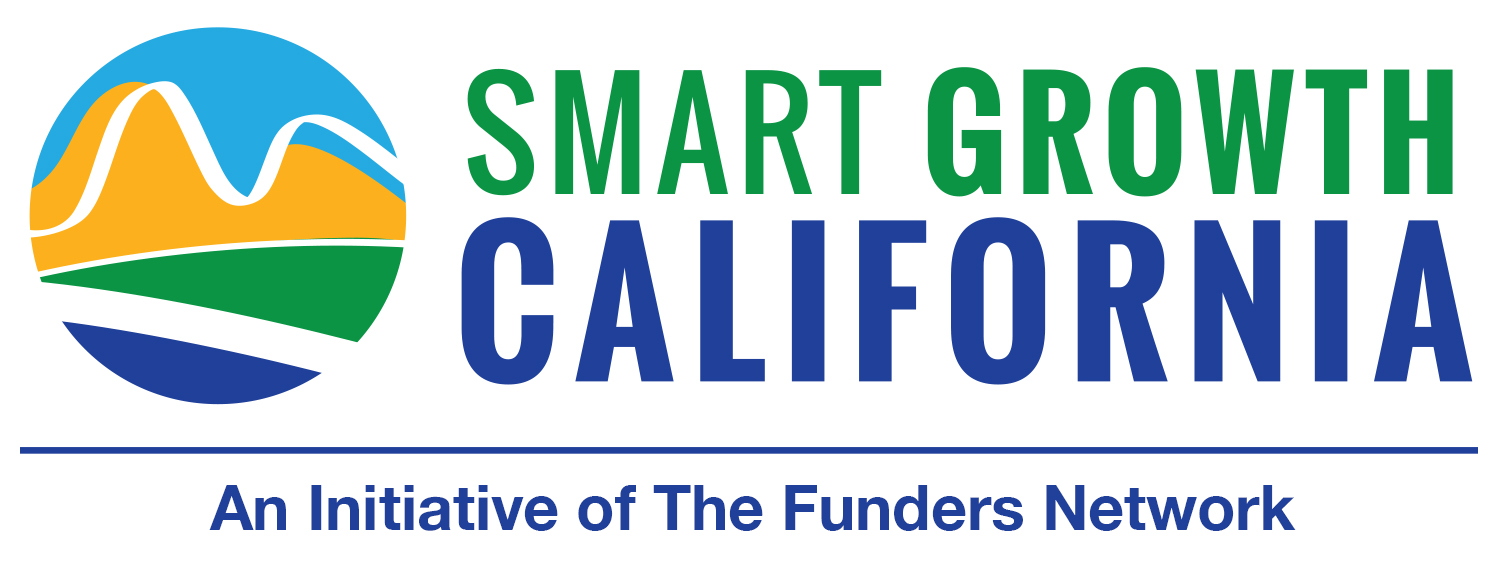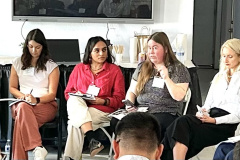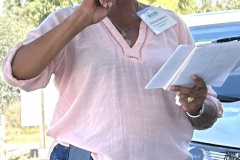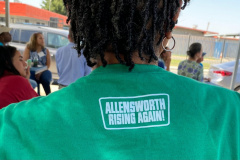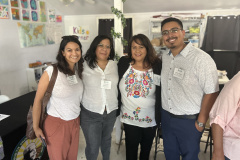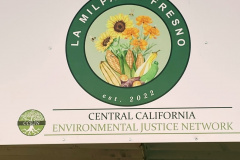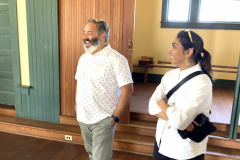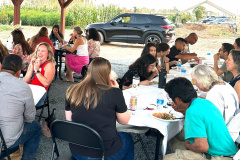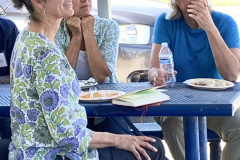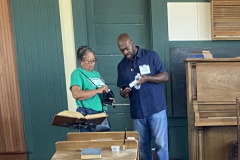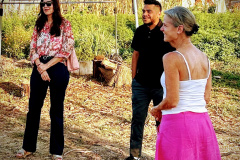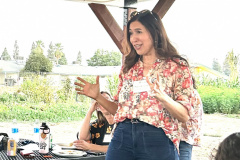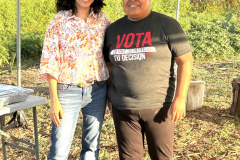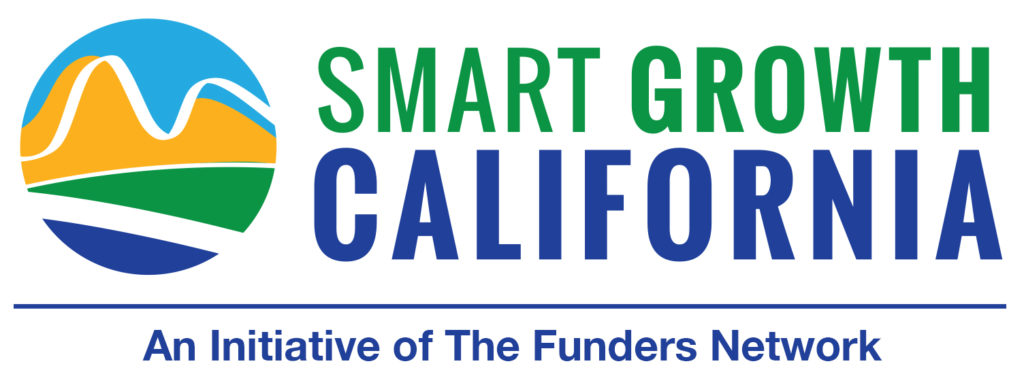
Something magical happened as we stepped onto La Milpa Farm. One minute we were driving past fast-food restaurants on a hot Fresno afternoon and the next, temperatures cooled as we walked alongside corn, squash and a riot of orange marigolds. The transformation from urban to rural was complete in the snap of a finger.
This is how we began the San Joaquin Valley Funders’ Collaborative fall gathering, which drew about 35 funders and more than a dozen Valley-based practitioners. Kicking off with a farm-grown meal and concluding 24 hours later with gratitude for our time at the historic Black community of Allensworth, we connected with each other and the stories around us, witnessing the power of lifting up community vision and voice. Here are some highlights of our gathering.
La Milpa’s Lessons
La Milpa Community Farm grew from conversations led by the Fresno-based Central California Environmental Justice Network, which heard a common theme from agricultural workers throughout the region: Residents dreamed of growing their own food.
“These people are farm workers by day, they work very long hours,” Nayamin Martinez, who leads CCEJN, told me recently. “But they still have the energy to do more farming because it’s for their families.”
As we walked through rows of tomatoes, squash and other fruits of their labor, we learned what La Milpa means. For Catalina, it’s a place to grow community along with native Oaxacan plants unavailable in stores, like chepil and papalo. For Rosario, it’s been a chance to deepen his expertise in the science of composting as part of a partnership with UC Merced.
Composting: Equitable Access to Climate Solutions
The success of La Milpa has prompted Martinez to investigate strategies for buying land to expand the farm, which now sits on rented property. Longterm control of land owned by community members would allow the farm to grow on its own terms and address other community needs such as housing.
That idea has support from the San Joaquin Valley Funders’ Collaborative’s Equitable Land Access (ELA) Ad Hoc, which has aligned more than $1 million to offer technical assistance and direct support to organizations including CCEJN, the Allensworth Progressive Association and others seeking community land ownership. These ELA funders include the California Endowment, Tao Rising, the 11th Hour Project and the Common Counsel Foundation’s Community Ownership for Community Power Fund.
Resident farmers at La Milpa are interwoven into $1 million study aimed at bringing low-cost climate solutions – like small-scale composting – to the Valley; it’s part of UC Merced research in which Prof. Rebecca Ryals is testing techniques for composting green waste that would otherwise go to landfills and release greenhouse gasses. We got a demonstration of the composting experiments under way and, after a beautiful orange sunset, we had a sweet ending to a perfect visit: home made Oaxacan ice cream.
Allensworth and Community Representation
Bagels, coffee and warm welcomes greeted us the next morning at the Allensworth Progressive Association, about 80 miles south of Fresno in Tulare County.
Janaki Anagha of the 11th Hour Project lead a conversation about community representation and community benefits in the San Joaquin Valley, against the backdrop of a state initiative known as California Jobs First. This initiative has given roughly $20 million to regions throughout the state – and promises more in competitive funding – as incentives for creating inclusive economic development plans that transition jobs towards clean energy industries.
We heard about how Valley-based funders have been involved in two of these planning efforts. Christy Patch and Angela Castallanos of the Central Valley Community Foundation shared a presentation on their region’s plan, known as Sierra San Joaquin Jobs (S2J2). More than 4,000 residents throughout Fresno, Madera, Tulare and Kings counties were engaged in their process, and the resulting $85 billion investment plan created by S2J2 was informed by that outreach.
Amy Portello-Nelson of the San Joaquin Community Foundation helped lead community outreach for North Valley Thrives, a California Jobs First plan covering San Joaquin, Stanislaus and Merced counties. She echoed similar themes raised by Patch and Castallanos – including the sprint represented by such massive community outreach — and also spoke of tensions inherent in soliciting “meaningful” community engagement at the pace required.
How Do Communities Benefit?
A key strategy within both S2J2, North Valley Thrives and other California Jobs First plans is attracting renewable energy industries to build solar, hydrogen and other projects.
Veronica Garibay, of the Leadership Counsel for Justice and Accountability, and Ingrid Brostrom of the UC Merced Community and Labor Center, focused their remarks on the challenges presented by the coming clean energy projects planned largely for rural areas unprepared to negotiate community benefits. The S2J2 plan includes an entire community benefits framework (page 394 of this document) that calls for legally binding community benefits agreements in order to secure necessary permits, a high and important bar. But the political will necessary to to achieve such goals is another question.
In a sign of such challenges, a bill signed last month by Gov. Newsom, AB 2661 paves to way for Westlands Solar Farm, which could become the largest solar farm in North America without a clear path forward on community benefits. With amendments introduced by the Leadership Counsel, the bill requires a community benefit plan. But the bill’s authors define “community” as a government agency.
Both Brostrom and Garibay emphasized the need to listen to rural communities where clean energy projects will be sited about what they want and offer technical assistance where desired. (For further discussion on the issue of community benefits in unincorporated places, join our upcoming webinar on this issue Nov. 12 from 2 – 3:30 PM).
Allensworth’s History and Future
At noontime, we stepped outside to eat Mexican food in the shade and hear the amazing story of Allensworth. It was founded in 1908 by a runaway slave who became a Civil War officer, Col. Allen Allensworth. After retiring from the military, Allensworth and others traveled west to escape the Jim Crow South, creating a ranching and farming community for free Blacks.
Today, the history of Allensworth is preserved within a California State Park that contains weathered Victorian cottages and an original one-room schoolhouse. Adjacent to the state park lies a grid of homes where the Allensworth Progressive Association is building off Allensworth’s history and propelling it into the future.
The APA’s Denise Kadara described how she and her family followed in their mother’s footsteps to devote their considerable time and talent to preserving Allensworth’s history, and realizing its potential.
Preserving the Past by Preparing for the Future
We learned about a beginning farmer training program for women and people of color that recently graduated its first class. Plans for agri voltaics are also in the works, which would collect energy from the sun while allowing compatible crops to grow alongside the panels. We visited the story-telling center within Allensworth State park with Kadara and heard plans for a dramatically improved version, paid for with funding from the state. And we stood under a 100-degree sun in a historic cemetery where formerly enslaved people are laid to rest.
There, Kadara’s sister, Sherry Hunter, president of the Allensworth Community Services District, acknowledged the crucial help provided by a nearly $100,000 grant from the Central Valley Community Foundation to fence the gravesites; however, another $50,000 long-promised by the USDA has been tied up in endless red tape, she and others said.
Prof. Alison Kirsch of University of Southern California has partnered with Allensworth to create a preservation plan for the historic cemetery, where gravesites are ill-kempt and in some cases knocked over by intruders. Kirsch said sonar studies could help locate the remains of former residents so that headstones and proper protections could be put in place.
Public-Private Partnership
Some of Allensworth’s many projects are supported by public funding. But almost all have been kick-started by philanthropy, Kadara said, giving special thanks to Kat Taylor, who was the first to invest in Allensworth’s rebirth. Other funders now include The California Endowment, the 11th Hour Project, Common Counsel Foundation, the Sierra Health Foundation and Tao Rising.
We closed out the day in a gratitude circle and words of appreciation for what’s possible when communities like La Milpa and Allensworth are supported to build their dreams.
If you have questions about the San Joaquin Valley Funders’ Collaborative, are interested in joining our bi-monthly meetings or have ideas for topics we should cover, reach out to Diana Williams at diana@fundersnetwork.org for more information.
Diana Williams is a Program Manager for Smart Growth CA, which is an initiative of The Funders’ Network. She coordinates the San Joaquin Valley Funders’ Collaborative, the Equitable Land Access ad hoc, and the Rural Funders Working Group.
